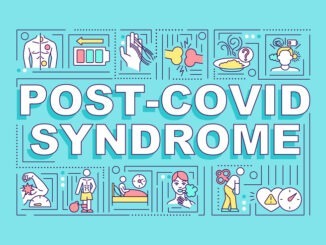
As cases of long COVID continue to rise, it is important that general practice stays on top of the latest figures and guidelines
The term ‘long COVID’ refers to prolonged symptoms following infection with SARS-CoV-2 that are not explained by an alternative diagnosis. It embraces the National Institute for Health and Care Excellence (NICE)’s terms ‘ongoing symptomatic COVID-19’ (symptoms lasting four-to-12 weeks) and ‘post COVID-19 syndrome’ (symptoms beyond 12 weeks), the US Centers for Disease Control and Prevention’s group of ‘post-COVID conditions,’ and the World Health Organization’s ‘post COVID-19 condition.’
In mid-2022 approximately 70% of the UK adult population had been infected with SARS-CoV-2; of these, almost two million people report COVID-19 symptoms persisting for more than four weeks, 807,000 (41% of all people with long COVID) for more than a year and 403,000 (19%) for more than two years.
NHS planning for improving services
The NHS plan for improving long COVID services provides an update on progress on the 10 actions set out in the NHS long COVID plan for 2021-22, and outlines the framework for deploying the £90m funding committed by the NHS for long COVID services during the 2022/23 financial year.
The plan has been developed with expert insights from those with lived experience of long COVID, clinicians, and partners across the health and care system. It builds on the significant progress made over the past two years and sets out action to ensure support is there for everyone who needs it, and that patients requiring specialist assessment and treatment can access care in a timely way.
NICE guidelines
NICE has issued official guidance on best practice for recognising, investigating and rehabilitating patients with long COVID. The guidance makes recommendations in a number of key areas, including:
- Assessing people with new or ongoing symptoms after acute COVID-19.
- Investigations and referral.
- Planning care.
- Management, including self-management, supported self-management, and rehabilitation.
- Follow-up and monitoring.
- Service organisation.
It also includes a number of key recommendations for research which will help inform and enhance future versions as evidence and practice develops.
Key information for general practice
Assessment and referral
Patients may present with a wide range of symptoms including, but not, limited to breathlessness, fatigue, chest pains, cognitive impairment or psychological symptoms. The initial role of healthcare professionals in primary care is to exclude acute or life threatening complications and other unrelated diagnoses. Assessment may include blood tests, chest X-rays or clinical tests, depending on the patient’s signs and symptoms (as per NICE/SIGN/ RCGP guidance).
Advice, treatment or referral to the relevant acute or specialist services may be required. Symptoms at four weeks from acute COVID-19 infection are common and, in most people, they represent the normal tail of recovery from the acute infection. Appropriate reassurance about the pace of recovery is likely to be helpful.
If ‘ongoing symptomatic COVID-19’ is diagnosed from four weeks after infection, and other diagnoses ruled are out, the following options should be discussed with the patient as appropriate to their needs:
- Signposting to self-management support, including the online platform Your COVID Recovery.
- Supported self-management from the practice or primary care network team; this may include input from social prescribers, health and wellbeing coaches and care co-ordinators who can also link into community groups or other existing community services as appropriate.
- Referral into a post-COVID service any time from four weeks after the start of acute COVID-19 illness. However, typically, referral will not be immediate due to the need to rule out alternative diagnoses and undertake relevant investigations.
Data management and coding
Data is critical if we are to learn more about this new condition, including its prevalence and natural history, in order to inform clinical management and service planning and design. Data on long COVID needs to be consistently and accurately coded and captured in primary care. The core SNOMED codes for general practice are:
- post COVID-19 syndrome (1325161000000102): 12 weeks plus after infection;
- ongoing symptomatic COVID-19 (1325181000000106): 4–12 weeks after infection;
- referral to post-COVID assessment clinic (1325031000000108);
- signposting to Your COVID Recovery (1325021000000106); when signposting patients to the public Your COVID Recovery website (Phase 1);
- post COVID-19 syndrome resolved (1326351000000108); to be used at the patient’s and clinician’s discretion when all symptoms have fully-resolved and there is no evidence of persisting organ impairment, or if an alternative diagnosis has been made that accounts for all symptoms.
Please note that healthcare professionals need to enter ‘Post-COVID’ (with the dash) when searching for the codes. Further guidance on coding, including recommended code sets, is available in the national commissioning guidance for post-COVID services.
A number of templates are available within the major EPR systems to support general practice assessment and coding of long COVID. These have been co-designed with, and align with, NHS England guidance, eg:
- TPP SystmOne – Long Covid Management Primary Care 1.0 ‒ access using ‘Search Features’ function → type ‘long’ to bring up.
- EMIS – Long COVID Management v1.0 ‒ access using Template Runner → type ‘long’ to bring up.
- Ardens – Long COVID Template.
‒ see website for details on how to access and use.
To improve detection of possible cases of long COVID, practices are encouraged to routinely code COVID-19 diagnosis (or add COVID-19 as a ‘Problem’) for those who test positive for COVID-19.


Be the first to comment